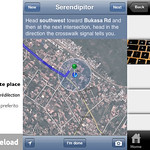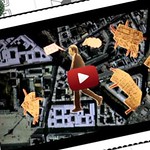Psychogeography apps
So I did a write up on dérives a few days ago, a dérive being an assisted random wandering around an urban area. The term and concept date from the 1950s, when ideas about psychogeography, the study of how a person’s environment effects his experience, were starting to take shape in Europe.
I now looked at the possibilities of expanding or rebuilding the interesting, but technically limited, deriveapp and did more of a background search. Turns out, psychogeography has an active following, not in the least because a few prominent writers, such as Will Self, have a particular interest in the field.
The blog The Pop-Up City (run by Dutchees), which looks at what will shape the city of the future, had a nice writeup on psychogeography in January this year, listing several massively interesting recent psychogeographical projects.
The blog posts mentions the very interesting iOS app Serendipitor, which is close in functionality as what I envisioned in my previous post. Serendipitor, a creation of Mark Shepard, claims inspiration from the analog Drift Deck, as well as the Fluxus movement *and* Yoko Ono (though I would argue Ono never left Fluxus).
The Serendipitor assists you in a dérive, similar to the dériveapp, but shows an actual map, and still, for the map, relies on an internet connection. The tasks of the two apps are similar, though Serendipitor sticks to plain text, while the tasks are a bit more akin to those that showed up in the analog Drift Deck.
Before you agree to a randomly generated route, you can specify you want a longer or shorter journey.
Then at the end of your journey, the app can send an email with your dérive to the Serendipitor website, where your dérive is stored for posterity, complete with tasks, route and photos. Sadly, almost annoyingly, the app only *almost* gets it exactly right: the meander is stored as an image, while neither the geographic locations of your photos, nor where you fulfilled your tasks, are stored, or at least, not displayed. Just a little bit of extra information would have made the app perfectly hackable, automatically creating the lovely maps Eduardo Cachucho put together based on the deriveapp.
It’s quite possible Serendipitor mails the photos with the geotags intact, meaning that hacking the app’s output might be somewhat possible.
Interestingly, not many people seem to be using the app, with on average 2 or so trips being posted to the site per month.
Drift, by Justin Langlois, helps you to ‘get lost in familiar places’. The app feels a bit buggy, but works. Like Serendipitor, photos have to be taken from within the app, meaning you can’t edit or adjust the photos you take. Drift also immediately uploads the photos you take, though it isn’t immediately clear where the uploaded photos go. Only after registering within the app and getting an email confirmation do you get mailed a link to a webpage, which really only contains a short blurb. In the app’s settings, you can specify your pics to be made public, but it took me contacting the author to learn where the resulting photos are shared. Still, individual or trip pages are not generated, meaning that your photos soon disappear into an unclear void.
One draw of deriveapp over both Serendipitor and Drift is that it’s very easy to change the cards/tasks. Particularly because some of the tasks used are very western-centric, being able to change them is useful for using the apps in out of the way locales. Serendipitor requires you at some point to find a fire hydrant. I don’t think I’ve ever seen one, here in Kampala. It also at some point requires you to ask someone to draw a map of his childhood. A request totally out of place, here.
Wanderlust stories takes a different approach, using scripted stories, transplanted to your locale through known foursquare locations, to give you a unique experience. It’s a web app and, obviously, becomes less interesting the more you use it, as the content doesn’t change, while it works better with a higher density of foursquare locations.
On the up, the authors allow for user submissions of stories, though this doesn’t appear to happen much, if at all.
The movie Inception came with an app which uses soundscapes related to your current surroundings and their state to, perhaps, induce lucid dreaming. Interesting for its use of sound levels and weather to determine what soundscape to play, but by no means a tool for a dérive.
The creators of the app, RjDj, followed this up with the app Dimensions, which effectively gamifies the Inception App, making it something of an immersive soundscaping experience, using location and ambient sounds as part of the gameplay. More promising than it seems to be able to deliver, another app by the same guys, simply RjDj mixes ambient tracks with ambient sound around you, resulting in an ever changing soundtrack to, well, your life. And it’s perhaps this least pretentious app which is the most successful of the three.
With some similarities to Dimensions, Shadow Cities is a location based multiplayer role playing game. Quite well executed and intriguing, I’ve played the game for a bit, but I’m not sure whether the fascination I have for the game is genuine or based on the game cleverly feeding the user a limited drip of information as the game progresses, constantly resulting in small surprises to retain interest.
Update: I forget to mention what perhaps is the mother of all dérive implementations: geocaching, which has a nice enough, if expensive, app. Geocaching is a GPS assisted treasure hunt. Originally done with a standalone GPS receiver and pen and paper, the hunt moved to smartphones a few years ago and has a strong following.
Though the resulting journey of one geocache is very much in line with a typical dérive, it’s impossible to partake without someone first having created a cache close to where you are. In built up areas in ‘the west’, this is less of a problem, but in other places, you might have to travel dozens, if not sometimes hundreds, of kilometers, to find a nearby cache. And, once you’ve done one cache, you can’t have another one be magically auto-generated. Geocaches, by design, rely on their exact location.
Update (October 2015): I stumbled upon another related app: Zufall (August 2020: No longer available).
Not exactly psychogeography material, but related in the same way that a photomarathon is, is InstaCC, which gives you, after selecting a group of tasks, a subject a day, for you to find a matching photo.
My biggest gripe with InstaCC is that, though well done, you’re required to pay for each individual list of assignments.
Three years ago, Ryan Raffa converted his own meanderings through New York City into sound, using latitude, longitude, speed and elevation as parameters for creating piano pieces. Care for an example.
Raffa used gpsed.com to track his dérives, for example with this trip. gpsed.com is an excellent resource for tracking trips, mapping both route and photos taken. On the downside, the website looks like it hasn’t been updated since 2002 and, though there is an app for iOS, there isn’t one for Android.
The iOS app works well in that it keeps track of your route, allows you to set waypoints and allows you to add photos. Here, too, though, the photos are made within the app and can’t be picked up from your camera roll. Though gpsed apparently allows for adding photos to the track later, from services like Flickr or Picasa.
Karl Heinz Jeron created an audio guide of Brussels, where he seems to have used the Gutenberg project as an intermediary to introduce a randomized aspect to the walk.
A somewhat dated post over at futureeverything.org lists a few other apps with links to psychogeography. A few more interesting, and less obvious, ones are…
+ WalkBrighton. If only I knew when I was there in March.
+ Glow. This records and shows users’ moods, overlaid on a map. Cute, but because it only uses the app as a data source, or so it seems, and not, for example, moods based on Tweets, the data is very limited.
+ A data logger from Pachube.
Next up: comparing the three dérive apps I’m now aware of, deriveapp, Drift and Serendipitor, and musings on what a dérive app should be able to do.
The image accompanying this post is a composite of images from WalkBrighton, Glow, InstaCC and Serendipitor.




